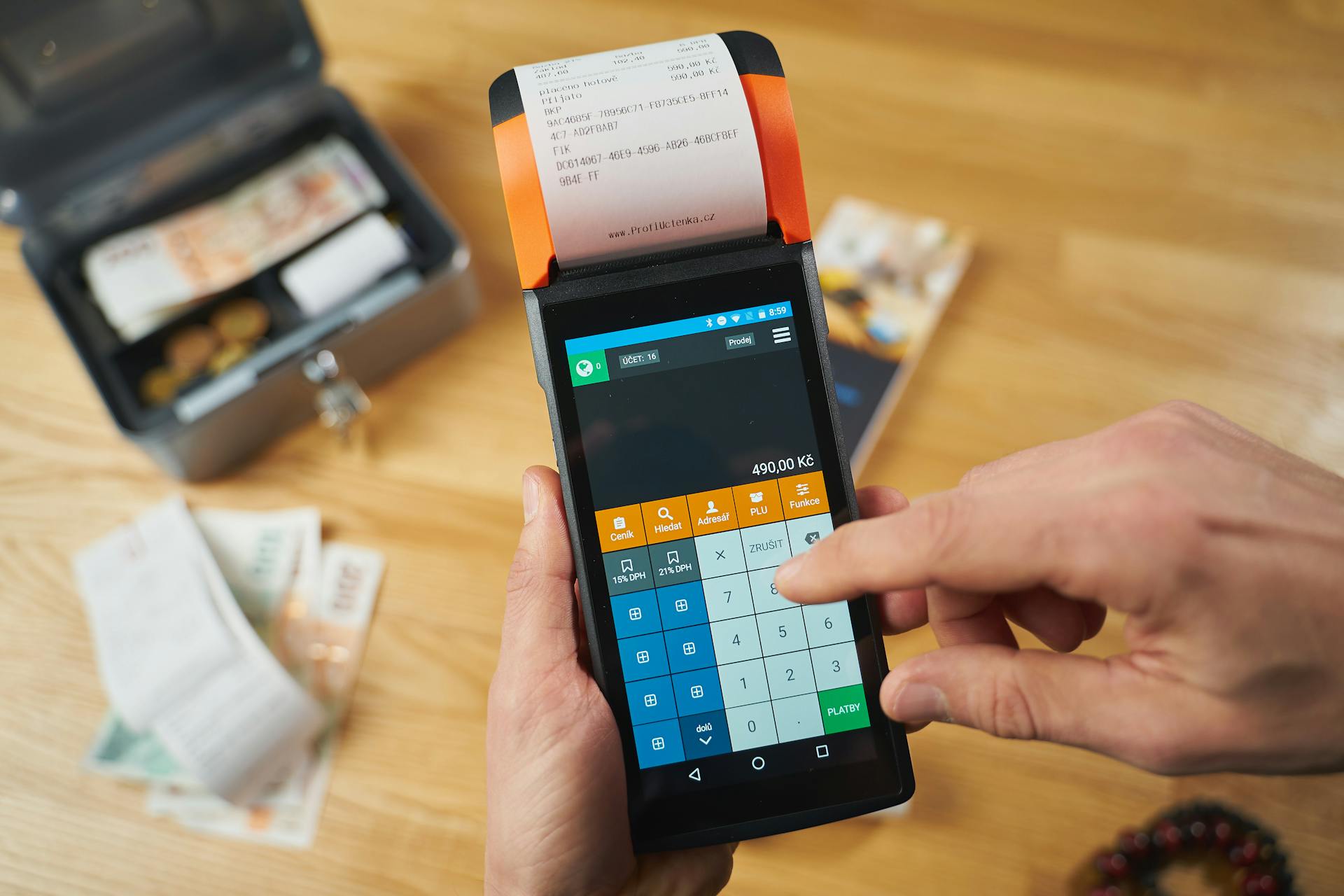
Streamlining Accounts Receivable with Lockbox Services is a game-changer for businesses.
By automating the process of collecting payments, lockbox services can reduce the time it takes to receive payments from 30 to 5 days.
This means businesses can free up more time and resources to focus on core operations.
Lockbox services also eliminate the need for manual data entry, reducing the risk of errors and increasing accuracy.
With lockbox services, businesses can enjoy faster payment processing, improved cash flow, and a more streamlined accounts receivable process.
For your interest: Do Banks Process Payments on Saturdays
What Is?
Lockbox banking is a service provided by banks to companies for the receipt of payment from customers. Payments made by customers are directed to a special post office box instead of going to the company.
The bank retrieves the payments from the box and processes them. This streamlines the payment process for companies.
Lockbox banking allows companies to receive payments more efficiently, as the bank handles the retrieval and processing of payments. This saves companies time and resources.
The bank deposits the funds directly into the company's bank account.
See what others are reading: List of Predatory Lending Companies
Benefits and Advantages
Lockbox (accounts receivable) offers several benefits and advantages that can streamline your financial operations.
Accelerating cash flow is one of the key benefits, as offering 24/7 payment channels can reduce mail float and wait times. This allows you to receive payments faster, giving you a better cash flow.
Streamlining billing and payments is another advantage, as automated workflows can save time and reduce manual effort. This efficiency gain can be a huge relief for back-office staff.
Enhancing customer satisfaction is also a benefit, as providing flexible, secure payment options through multiple digital channels can increase customer satisfaction. This is especially true for customers who value convenience and speed.
Increasing payment security is another advantage, as advanced fraud prevention and data protection features can protect your business from potential threats. This is crucial in today's digital age where security is top priority.
Here are some key benefits of a traditional lockbox:
- Mail float speed-up: Lockbox processing can reduce mail float in a couple of ways, making delivery faster.
- More flexibility for the payer: Lockboxes benefit the payer by allowing them to use the mail float to their advantage.
- Back-office staff efficiency increases: Lockbox processing at scale can increase efficiency and reduce manual effort.
By implementing a lockbox system, you can gain real-time financial control with detailed tracking, reporting, and payment history. This level of control can help you make informed decisions about your financial operations.
Secure Storage
Secure Storage is a top priority when it comes to managing your accounts receivable. With the right Lockbox solution, you can enhance secure information management with multiple levels of access and security.
This means that sensitive data is protected from unauthorized access, giving you peace of mind and confidence in your financial management. You can rest assured that your medical information, high-dollar corporate payments, and consumer payments are all secure.
The Lockbox solutions offer multiple levels of access and security, allowing you to control who can view and manage your data. This is particularly useful for companies that receive a large volume of sensitive payments.
Here's a breakdown of the Lockbox solutions and their security features:
By choosing the right Lockbox solution, you can ensure that your data is secure and protected from unauthorized access. This will give you confidence in your financial management and help you focus on more important things.
Functionality and Integration
Lockbox banking offers a range of benefits, but its functionality and integration capabilities are just as important. Many lockbox banking services can be integrated with popular accounting software, streamlining the payment reconciliation process by automatically importing lockbox transaction data into the accounting system.
This integration can save businesses a significant amount of time and effort, making it a crucial aspect of a lockbox banking system.
What Is a Payment?
A payment is simply the act of transferring money from one party to another, and it can take many forms, such as a check or an electronic transfer.
The process of making a payment can be streamlined with the use of lockbox payments, which allow businesses to receive payments in a secure and efficient manner.
Lockbox payments are collected by a bank representative who gathers the money from a designated box, usually on a daily basis.
The bank then uses an outsourced team to process the payments, either manually or through the use of optical character recognition (OCR) and Check21.
These payments are then digitized and made available on a secure website for the business to access.
Daily reports and nightly backups are also provided to give the business peace of mind and a clear view of their financial management.
For your interest: Ubs Interview Process
Software Integration
Many lockbox banking services offer integration with popular accounting software, allowing businesses to streamline their payment reconciliation process by automatically importing lockbox transaction data into their accounting system.
This integration can save businesses a significant amount of time and reduce errors, as it eliminates the need for manual data entry.
Some lockbox banking services offer wholesale lockbox for high-value payments, retail lockbox for lower-value payments, and electronic lockbox for digital payment processing, making it easier for businesses to choose the right solution for their needs.
Digital lockboxes replace the physical address of a traditional lockbox with a digital web address, using electronic payment methods like eChecks, ACH, debit cards, credit cards, and electronic bank transfers.
Electronic lockboxes are automated, giving businesses access to their funds quickly, and can even convert paper checks into digital form for customers who prefer it.
Specialized software can increase the productivity of businesses by allowing them to receive electronic data and images from the bank, and automation can quickly move the images into document-management systems, work-flow systems, and accounting systems.
Take a look at this: Monopoly Electronic Banking Rules
Don't Integrate

Manual matching of customer information during payment can be a time-consuming task, taking hours to reconcile the deposit to the information in the record system.
Lockboxes don't tie into your system, so back-office teams have to spend hours reconciling the deposit to the information in their record system.
This lack of integration can lead to errors and inefficiencies in the payment process, causing frustration for both customers and staff.
Explore further: Fedwire Hours
Cost and Efficiency
Receiving cash sooner through lockbox banking can have a significant impact on your business's cash flow. This is because funds hit your bank account faster, allowing your deposits to begin earning interest revenue sooner.
Setup fees for lockbox banking can range from a one-time fee to cover the initial setup and implementation of the system. These fees vary by bank, but they're a necessary cost to get started.
Transaction-based fees are another cost to consider, assessed for each payment accepted through the lockbox system. These fees can differ depending on the method of payment, the number of items handled, and any additional services required.
Expand your knowledge: Amortizing Loan Origination Fees

Monthly maintenance fees ensure the lockbox service continues to be available, regardless of the number of transactions. These fees cover the cost of continuous service management and administration.
To give you a better idea of the costs involved, here's a breakdown of the typical fees associated with lockbox banking:
Keep in mind that these fees can vary depending on the bank and the specific services you need. It's essential to carefully consider these costs to ensure lockbox banking is the right choice for your business.
Comparison and Limitations
Lockbox accounts receivable has its advantages, but it's not without its limitations. One major limitation is that it can be inflexible, making it difficult to accommodate changes in business needs.
The traditional lockbox system, for example, relies on paper checks and manual processing, which can be slow and prone to errors. This can lead to delayed payments and frustrated customers.
In contrast, digital lockbox solutions offer more flexibility and efficiency, but they can be more expensive to implement.
Advantages and Disadvantages

The advantages of a traditional lockbox are numerous. Mail float speed-up is one of the most significant benefits, allowing payments to be deposited on the same day they're received.
With lockbox processing, payers have more flexibility, as they can use the time required for mail delivery to their advantage. This is often referred to as "the check is in the mail."
Lockboxes reduce mail float in two ways: by using locations near customers to speed up delivery and by having bank staff deposit payments into the account. This means payments are received and deposited on the same day.
Back-office staff efficiency increases with lockbox processing, as banks do it at scale, eliminating the need to prepare deposit slips, drive to the bank, or build reports. This allows for further scaling of the volume of checks without hiring additional staff.
Here's a summary of the advantages of a traditional lockbox:
- Mail float speed-up
- More flexibility for the payer
- Lockboxes reduce mail float
- Back-office staff efficiency increases
Are Still Slow
Traditional lockbox services may seem like a faster alternative to sending checks, but they're still slow. They're not digital or electronic, which means the time saved is minimal.

Legacy lockbox systems take longer than their digital counterparts, and the funds are not available in real time. This is because the check still needs to be deposited and processed by a bank employee.
While lockboxes may lessen the time a check is in the mail, the time saved is negligible.
On a similar theme: Bet 365 Online Banking Withdrawal Time
Accounting and Reconciliation
Businesses using lockbox banking can substantially lower their internal processing costs, speed up collections, and convert their receivables into cash more quickly.
Lockbox banking automates the process of preparing bank deposits and maintaining accounting records, making it easier for companies to manage their receivables. This helps reduce the number of days their customers' checks are outstanding.
By using lockbox banking, businesses can increase their internal control and efficiency in receivables management, while also improving audit controls and data security. Daily access to deposit amounts, fund availability, and payment information is also provided.
To reconcile lockbox transactions, businesses can use the information provided by the bank in the form of reports, which typically include details about each payment received, such as the payer's name, amount, and invoice number.
Broaden your view: Receivables Days Formula
Suitability and Types

Lockbox banking can be beneficial for small businesses, allowing them to improve their cash flow and focus on core operations.
Small businesses can accelerate the collection and processing of payments, reducing manual payment handling.
Different types of lockbox banking services are available to meet varying business needs, including wholesale lockbox for high-value payments and retail lockbox for lower-value payments.
Electronic lockbox services are also available for digital payment processing, offering a convenient and efficient option for businesses.
Check this out: Bank Services Billing Standard
Suitable for Small Businesses?
Lockbox banking is a game-changer for small businesses, allowing them to improve their cash flow by accelerating the collection and processing of payments.
This means small businesses can focus on their core operations, rather than getting bogged down in manual payment handling.
Types of Services
There are different types of lockbox banking services available to meet varying business needs. Some common types include wholesale lockbox for high-value payments, retail lockbox for lower-value payments, and electronic lockbox for digital payment processing.
Intriguing read: European Payments Initiative

Wholesale lockboxes are for corporate-to-corporate payments and tend to be higher dollar amounts than retail lockbox transactions.
Retail lockboxes are for companies with high volumes of consumer-oriented payments, such as utility payments and loan payments, and these remittances often include a standardized "payment coupon".
Digital or electronic lockbox services offer a faster, more secure, and more efficient alternative to traditional lockbox accounting systems. They use electronic payment methods like eChecks, ACH, debit cards, credit cards, and electronic bank transfers.
Recommended read: Retail and Consumer Banking
Frequently Asked Questions
What is an AR lockbox?
An AR lockbox is a service that helps businesses process large volumes of customer payments efficiently, allowing them to outsource their accounts receivable payment processing. It's a secure and streamlined way to manage millions of transactions each month.
Is a lockbox the same as a PO box?
A lockbox is a specific type of PO box used for commercial banking, whereas a PO box is a general mail receptacle. While both serve as alternative mailing addresses, a lockbox has additional banking features.
Sources
- https://docs.oracle.com/cd/A60725_05/html/comnls/us/ar/docs03.htm
- https://www.truist.com/commercial-corporate-institutional/manage-cash-flow/receivables
- https://www.investopedia.com/terms/l/lockboxbanking.asp
- https://en.wikipedia.org/wiki/Lockbox_(accounts_receivable)
- https://www.paystand.com/blog/lockbox-services
Featured Images: pexels.com


